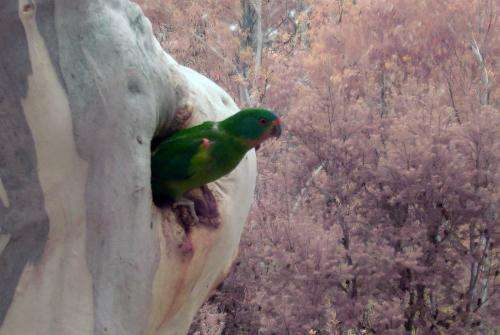Forest loss linked to swift parrot mortality

(Phys.org) —New research has found the endangered swift parrot is more likely to be killed and eaten by sugar gliders in Tasmania in areas where forests are disturbed or lost compared to areas of intact forest.
The research took place over a three-year period, and compared populations of swift parrots from mainland Tasmania where sugar gliders also live, to those on islands where sugar gliders are absent.
"Across the Tasmanian mainland, we found a link between deforestation and increasing predation on parrot nests by sugar gliders," says chief investigator, ANU Postdoctoral Fellow and conservation biologist Dejan Stojanovic.
"On offshore islands where sugar gliders are absent, no swift parrot nests failed due to predators, whereas on the Tasmanian mainland, sugar gliders caused the failure of 83 per cent of swift parrot nests, and in most cases, the adult female parrot was also killed and eaten."
Stojanovic says his research found that in locations where forest loss was severe, predation on swift parrots and their nests could be as high as 100 per cent. However, survival of parrots and their nests improved as cover of old growth forest increased.
"Our data suggest that when deforestation is minimal on the Tasmanian mainland, survival of swift parrot nests improves even when sugar gliders occur in the area," he said.
The research is the first to document sugar gliders acting as the primary cause of mortality for any bird.
"Up until we did this research it was assumed that gliders were only nectar and insect feeders," he said.
"Other studies had found that gliders occasionally eat birds, but nobody expected that their impacts could be this severe and widespread.
"The unexpected links between land clearing and predation on nesting swift parrots took us by surprise. Our discovery highlights the need for urgent research to clarify how forest loss in Tasmania impacts the survival of endangered swift parrots."
Sugar gliders, a native to the Australian mainland, are widely considered to have been introduced into Tasmania in the 1800's.
Stojanovic says his team is working to untangle the complex synergies between forest loss, sugar gliders and swift parrots, with an aim to improve the management of the remaining swift parrot habitat.
More information: Stojanovic, D., Webb, M. H., Alderman, R., Porfirio, L. L., Heinsohn, R. (2014), "Discovery of a novel predator reveals extreme but highly variable mortality for an endangered migratory bird." Diversity and Distributions. doi: 10.1111/ddi.12214
Journal information: Diversity and Distributions
Provided by Australian National University



















